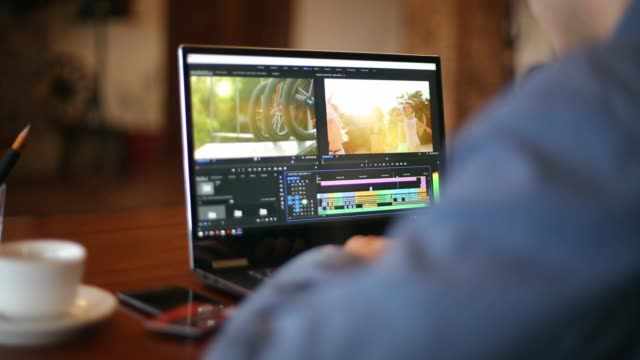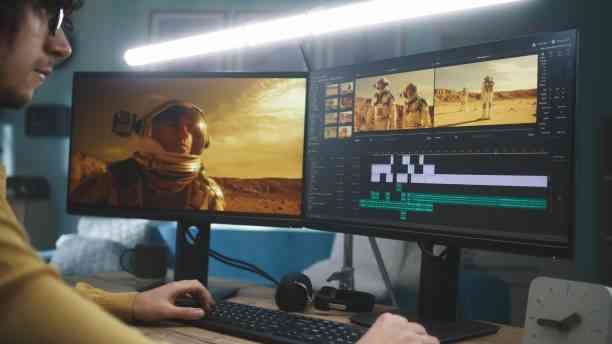In the realm of video editing, one of the fundamental decisions a content creator must make is whether to invest in a laptop or a desktop. Both options offer distinct advantages and disadvantages, catering to different needs and preferences. In this comprehensive guide, we’ll delve into the intricacies of video editing on laptops versus desktops, examining the pros and cons of each and recommending some top choices for both platforms.
Video Editing on a Laptop

Video editing on a laptop has become increasingly popular due to its portability and convenience. Modern laptops boast impressive processing power and graphics capabilities, allowing users to edit videos on the go without being tethered to a stationary setup. Whether you’re a freelance videographer, a YouTuber, or a filmmaker working on location, a laptop offers the flexibility to edit videos from virtually anywhere.
Advantages of Video Editing on a Laptop
- Portability: The primary advantage of video editing on a laptop is portability. Laptops allow you to take your editing workstation with you wherever you go, whether you’re traveling, working from a coffee shop, or collaborating with clients on-site.
- Space-saving: Laptops occupy minimal space compared to desktops, making them ideal for users with limited workspace. They can be easily tucked away when not in use, freeing up valuable real estate in your home or office.
- Integrated Display: Many laptops come with high-resolution displays that are well-suited for video editing. This eliminates the need for an external monitor, further streamlining your editing setup.
Disadvantages of Video Editing on a Laptop
- Limited Upgradeability: Unlike desktops, laptops are not as easily upgradable. While some components like RAM and storage may be replaceable, the overall upgrade options are more restricted. This means that as technology advances, your laptop may become obsolete sooner than a desktop.
- Performance Constraints: Although modern laptops boast impressive performance capabilities, they typically lag behind desktops in terms of raw processing power and graphics performance. This can result in slower rendering times and less efficient editing workflows, especially when working with high-resolution footage or complex effects.
- Thermal Constraints: Laptops are prone to heating issues, especially during intensive tasks like video rendering. Thermal throttling can occur, leading to decreased performance and potential hardware degradation over time.
Best Laptops for Video Editing
- Apple MacBook Pro: Renowned for its sleek design and powerful performance, the MacBook Pro is a favorite among professional video editors. With options for high-resolution Retina displays, robust processors, and ample storage, the MacBook Pro offers a seamless editing experience.
- Dell XPS 15: The Dell XPS 15 is a powerhouse laptop equipped with Intel Core i9 processors and NVIDIA GeForce GTX graphics, making it well-suited for demanding video editing tasks. Its stunning 4K display and compact form factor make it a versatile choice for content creators on the move.
- Razer Blade 15: Designed with gamers and creative professionals in mind, the Razer Blade 15 combines cutting-edge hardware with a sleek, portable design. Featuring NVIDIA RTX graphics and upgradable components, it delivers exceptional performance for video editing and gaming alike.
Video Editing on a Desktop

While laptops offer portability and convenience, desktops reign supreme in terms of raw power and customization options. Desktop workstations are the go-to choice for professional video editors who demand uncompromising performance and reliability.
Advantages of Video Editing on a Desktop
- Raw Processing Power: Desktops are equipped with powerful processors, high-performance graphics cards, and ample RAM, allowing for lightning-fast rendering and seamless multitasking. This makes them ideal for handling large video files and complex editing projects.
- Upgradeability: Unlike laptops, desktops are highly customizable and easily upgradable. You can swap out components such as CPUs, GPUs, and storage drives to keep your workstation up to date with the latest technology and performance enhancements.
- Better Cooling: Desktops typically feature advanced cooling systems, including multiple fans, liquid cooling solutions, and spacious chassis designs. This superior thermal management ensures optimal performance and prevents overheating during prolonged editing sessions.
Disadvantages of Video Editing on a Desktop
- Lack of Portability: The main drawback of desktops is their lack of portability. Unlike laptops, which can be carried anywhere, desktop workstations are stationary setups that require a dedicated workspace. This may not be suitable for users who need to edit videos on the go.
- Space Requirements: Desktops occupy more space than laptops and may not be suitable for users with limited room or mobility constraints. Additionally, setting up a desktop workstation requires additional peripherals such as monitors, keyboards, and mice, further adding to the space requirements.
- Initial Cost: While desktops offer superior performance and customization options, they often come with a higher upfront cost compared to laptops. Building or purchasing a high-end desktop workstation can be a significant investment, especially for users on a tight budget.
Best Desktops for Video Editing
- Apple iMac Pro: The iMac Pro is a powerhouse desktop workstation tailored for professional video editing and content creation. With its stunning 5K Retina display, Intel Xeon processors, and Radeon Pro Vega graphics, it delivers unparalleled performance and visual fidelity.
- Dell Precision 5820 Tower: The Dell Precision 5820 Tower is a versatile desktop workstation designed for demanding video editing workflows. Equipped with Intel Xeon processors, NVIDIA Quadro graphics, and support for up to 256GB of RAM, it offers exceptional performance and scalability.
- HP Z8 G4 Workstation: The HP Z8 G4 Workstation is a top-of-the-line desktop workstation optimized for high-end video editing and 3D rendering. Featuring dual Intel Xeon processors, NVIDIA Quadro RTX graphics, and extensive expansion options, it provides unmatched power and flexibility for professional users.
Conclusion
In the debate between laptops and desktops for video editing, there is no one-size-fits-all solution. Each option has its own set of advantages and disadvantages, catering to different needs and preferences. While laptops offer portability and convenience, desktops provide superior performance and customization options. Ultimately, the choice between a laptop and a desktop depends on your specific requirements, budget, and workflow. Whether you prioritize mobility or raw processing power, there are plenty of options available to suit your video editing needs.
Additional Thoughts
When making the decision between a laptop and a desktop for video editing, it’s essential to consider your workflow and editing environment. If you frequently travel or work on location, a laptop may be the more practical choice, allowing you to edit videos wherever inspiration strikes. However, if you require maximum performance and customization options, a desktop workstation is the way to go. Additionally, investing in high-quality peripherals such as external monitors, keyboards, and mice can enhance your editing experience and productivity, regardless of whether you choose a laptop or a desktop. Ultimately, the key is to choose the option that best aligns with your unique preferences, workflow, and budget constraints.


[…] Laptop vs. Desktop for Video Editing, Making the Right Choice […]